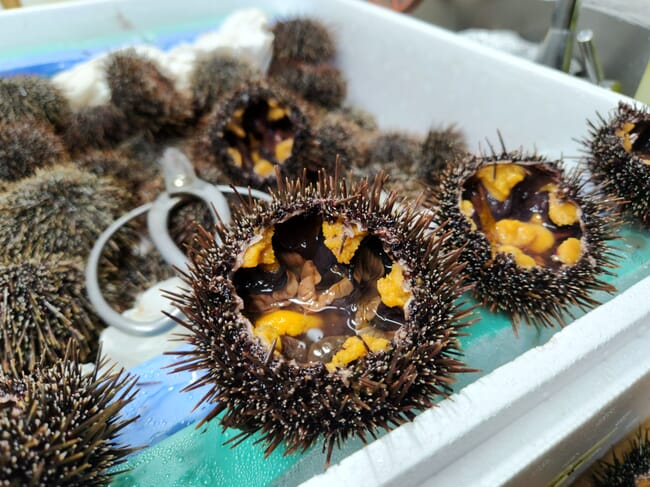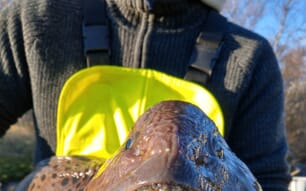
Kina that are found in barrens produce poor quality roe, making them unsuitable food for humans (and predators), therefore offering little incentive for the fishing community to remove them from the seafloor. © EnviroStrat and Kinanomics
In the last few decades, Aotearoa New Zealand’s rocky reef coastal ecosystems have undergone significant changes. We’re now facing a massive ecological challenge, but it’s one that most people don’t know about because it’s happening under the water. Vast stretches of our seafloor that were once abundant with dense kelp forests have been overtaken by exploding populations of kina (sea urchins), which have grazed the kelp down to bare rock.
The kina problem
The combination of the removal of kina’s natural predators (like snapper and crayfish) through commercial and recreational fishing – and impacts from land use and warming oceans – have led to a proliferation of these spiky herbivores. Populations of kina are eating their way through the kelp forests found along the rocky coastlines, reducing them to barrens and contributing to the loss of critical ecosystem services kelp communities provide, including habitat for fish, water quality improvements and carbon sequestration. Once the kelp is gone, the kina remain, and – having removed the very food source they rely on – the kina are able to survive for long periods with very little food, thus preventing the kelp forests from recovering.
Urchin barrens are a global problem, with similar issues seen in Norway, Japan, Australia, New Zealand and North America. In northern California, over 90 percent of kelp forests have been lost due to a range of environmental stressors, including overgrazing by purple sea urchins. This unprecedented loss of kelp habitat dramatically altered the structure and functioning of the coastal reef system, which has impacted biodiversity and the fishing sector in the US state, impacting local coastal economies.
The kina solution
Kina that are found in barrens produce very little and poor quality roe, making them a poor choice for kai (food) for humans and their predators, so there is little incentive to remove them from the seafloor. Until now.
EnviroStrat, in partnership with Ngati Porou Seafoods and restorative aquaculture company Urchinomics, is leading a pilot that blends fishing, aquaculture and conservation to turn the starved kina into a lucrative aquaculture opportunity, while supporting the regeneration of our coastal kelp forests and marine ecosystems.
The 18-month Kinanomics project proof of concept is exploring the viability of ranching wild-caught marginal kina in land-based aquaculture systems to produce a much sought after seafood delicacy for export into high-value Asian markets.
From the outside, kina look anything but tasty. But crack open that spiky shell and you’ll find a seafood delicacy that’s highly coveted. There is a growing global appetite for sea urchin roe (known as uni) and significant work done to date by Urchinomics helps us to understand the market for enhanced roe in global markets.
Japan accounts for 80-90 percent of global demand and imports 75-80 percent of its total consumption, but it’s facing competition from Chinese, South East Asian and North American buyers. The global market for uni is estimated to be approximately NZD$750-$920 million (£363-445 million), with demand significantly exceeding supply.
Currently in New Zealand, a small wild kina fishery exists but it is focused on fishing kina from areas where kelp and other seaweeds are abundant, and the roe condition is good. Most of New Zealand’s wild-caught kina is sold and consumed domestically, with limited exports into Australia.
Inspired by aquaculture pioneers
The Kinanomics project will adapt IP and methods developed by Urchinomics and build on research undertaken in New Zealand by National Institute of Water and Atmospheric Research (NIWA) scientists and others in the industry in the early 2000s.
Pioneered by Brian Tsuyoshi Takeda, Urchinomics involves the wild harvest of urchins from destructive barren zones and re-homing them in a land-based aquaculture facility for 8-12 weeks. Their roe is enhanced on a specially formulated aquafeed that has been developed to produce consistent, high quality roe that appeals to export markets until they are perfect for sale – regardless of where in the world the urchin has come from.
Urchinomics has also caught global attention for its environmental impacts. It was announced in December 2022 that Urchinomics had secured the world’s first kelp restoration blue carbon credit, issued after a successful research project in Kunisaki and Nagato, Japan. Urchinomics is one of three global commercial ventures leading actions endorsed by the United Nations Ocean Decade. Through its endorsed Decade Action, Urchinomics will contribute to meeting priority challenges of the Ocean Decade related to ecosystem management and restoration, and the development of a sustainable ocean economy. New Zealand is the latest country to pilot the Urchinomic’s methodology, with additional pilots at various stages of maturity underway in Japan, Norway, the United States, Canada and Australia.
A 12-week feed trial conducted in New Zealand in early 2022 proved the viability of using Urchinomics’ proprietary feed to enhance kina. The trial proved that kina respond well to the feed, with significant gains in condition, which produced a tasty bright yellow roe that is valued by chefs and consumers alike. The feed trial exceeded expectations and has provided the confidence to move towards a large-scale applied research commercial pilot.
Project funding
The NZD $2.2 million (£1 million) Kinanomics project, supported with nearly NZD $1 million (£484,000) investment from the Sustainable Food and Fibre Futures fund, administered by the Ministry for Primary Industries, seeks to establish an end-to-end supply chain for New Zealand-ranched kina. The project will explore fishing techniques, ranching, processing, export market analysis, future product opportunities, environmental and social impact, and future business models.
Throughout the project we’ll seek feedback from local chefs and international experts to ensure the enhanced uni appeals to our target markets. The assessment will include taste and sensory evaluations. Early feedback has been positive. Kina enhanced with the proprietary feed produced roe that had favourable size, taste, texture and colour characteristics.
Seabed restoration
Domestic and international research confirms removing kina improves and restores kelp habitats with significant flow-on benefits to fish populations, water quality, and climate change resilience. The Kinanomics project will explore ways to accelerate kelp recovery. This work will involve a number of local and international restoration experts to develop a seabed recovery protocol. To support this work, we will explore opportunities to directly invest into active kelp regeneration.
By utilising marginal kina from barrens, Kinanomics offers a commercial incentive to remove these malnourished urchins from our seafloor, not only creating job opportunities and commercial revenue, but enabling environmental restoration.
This article was first published as a blog post on the EnviroStrat website.




